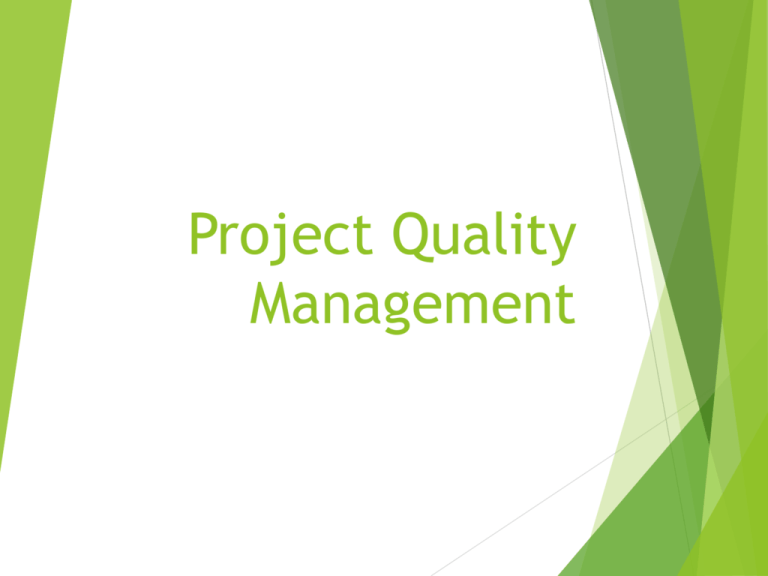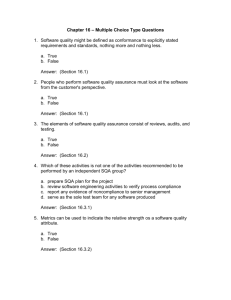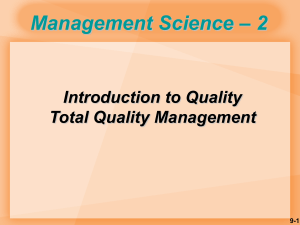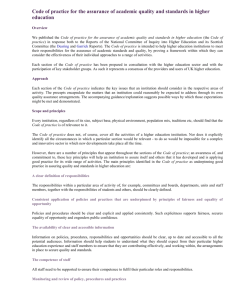quality control
advertisement

Project Quality Management Quality Certification (PMP is an ISO 9000 certified credential) ISO 9000: 2005 Quality Principles: Principle 1 Customer focus Principle 2 Leadership Principle 3 Involvement of people Principle 4 Process approach Principle 5 System approach to management Principle 6 Continual improvement Principle 7 Factual approach to decision making Principle 8 Mutually beneficial supplier relationships 9-2 Project Quality - Understand the importance of project quality; what is it? - Describe quality planning and its relationship to project scope management - List the three outputs of the quality control process - Understand a few tools and techniques for quality control What is Quality? Car Ride, Reliability, Fit and Finish, Audio System Food Taste, Smell, Color, Texture, Freshness Clothes Fit, Stitching, Comfort, Wear? Means different things to different stakeholders What is Quality? The International Organization for Standardization defines quality as the totality of characteristics of an entity that bear on its ability to satisfy stated or implied needs Other experts define quality based on – Conformance to requirements; meeting written specifications. – Fitness for use; ensuring a product can be used as it was intended. Purpose of QM To Ensure that the Project Will Satisfy the Needs for Which it was Undertaken. –scope –cost –performance –Meet or exceed customer satisfaction The Customer or End User Ultimately Decides if Quality is Acceptable. Period. PQM Processes 1. Quality planning: identifying which quality standards are relevant to the project and how to satisfy them 2. Quality assurance: evaluating overall project performance to ensure the project will satisfy the relevant quality standards 3. Quality control: monitoring specific project results to ensure that they comply with the relevant quality standards while identifying ways to improve overall Quality We will restate/review all this a bit later. Quality is Planned In 1. It is important to design in quality and communicate important factors that directly contribute to meeting the customer’s requirements 2. Design of experiments helps identify which variables have the most influence on the overall outcome of a process – (tests of change) 3. Many scope aspects of IT projects affect quality like functionality, features, system outputs, performance, reliability, and maintainability (underscoring scope mgt.) Objectives Steps to Attain Related to Goal The Objective Related to my Goal Measures Timeframe – Date Objective is to be Accomplished Notes 8-10 Scope, Time, Risk, Human Resources, Procurement, Quality, Communication, Cost, Stakeholders, Quality Assurance Quality assurance includes all the activities related to satisfying the relevant quality standards for a project Another goal of quality assurance is continuous quality improvement Benchmarking can be used to generate ideas for quality improvements Quality audits help identify lessons learned that can improve performance on current or future projects Quality Assurance Plan For big projects, it can look like a book complete with chapters and indices if not on e-doc Key projects of any size require some sort of plan to ensure quality standards are met Quality Control The main outputs of quality control are – acceptance decisions – rework – process adjustments A few tools and techniques include Pareto analysis statistical sampling Six Sigma – major quality endeavor quality control charts Using your own critical eye Pareto Pareto analysis involves identifying the vital few contributors that account for the most quality problems in a system • Also called the 80-20 rule, meaning that 80% of problems are often due to 20% of the causes • Pareto diagrams are histograms that help identify and prioritize problem areas Statistical Sampling and Standard Deviation • Statistical sampling involves choosing part of a population of interest for inspection. The size of the sample depends on how representative you want the sample to be. Six Sigma (Represents a Standard Deviation) Six Sigma is “a comprehensive and flexible system for achieving, sustaining and maximizing business success. Six Sigma is uniquely driven by close understanding of customer needs, disciplined use of facts, data, and statistical analysis, and diligent attention to managing, improving, and reinventing business processes.”* *Pande, Peter S., Robert P. Neuman, and Roland R. Cavanagh, The Six Sigma Way. New York: McGraw-Hill, 2000, p. xi Six Sigma Basic Info The target for perfection is the achievement of no more than 3.4 defects per million opportunities The principles can apply to a wide variety of Processes. It represents a standard - an ideal. Six Sigma It is an operating philosophy that is customer-focused and strives to drive out waste, raise levels of quality, and improve financial performance at breakthrough levels Requires organization-wide commitment Modern QM - Noted Quality Experts – Recognize their Names Modern quality management – requires customer satisfaction – prefers prevention to inspection – recognizes management responsibility for quality Noteworthy quality experts include Deming, Juran, Crosby, Ishikawa, Taguchi, and Feigenbaum Deming was famous for his work in rebuilding Japan car industry and his 14 points. Juran wrote the Quality Control Handbook and 10 steps to quality improvement. Re-defined quality focused on the customer’s view, fitness for use not the manufacture’s view, conformance to requirements. Crosby wrote Quality is Free and suggested that organizations strive for zero defect; looked at the total cost of poor quality. Ishikawa developed the concept of quality circles and pioneered the use of Fishbone diagrams Taguchi developed methods for optimizing the process of -- engineering experimentation -- Quality should be built in not inspected in. Feigenbaum developed the concept of total quality control – Quality is the responsibility of people who do the work. “It is most important that top management be quality-minded. In the absence of sincere manifestation of interest at the top, little will happen below.” (Juran, 1945) A large percentage of quality problems are associated with management, NOT technical Issues. It’s about the PEOPLE. Fun With a Fishbone Ishikawa is Easy The Cost of Quality – the cost of conformance or delivering products that meet requirements and fitness for use – the cost of nonconformance or taking responsibility for failures…or not meeting quality expectations PMBOK Processes Q Planning = used to determine the relevant quality standards…generates the PLAN. The PLAN becomes a major input item into 1. “perform quality assurance” 2. “perform quality control” What is Quality Assurance? The process of *auditing* the quality requirements and the results from quality control measurements to ensure appropriate quality standards and operations definitions are used. Perform Quality Assurance Makes recommendations for changes that --after approval by the integrated change control process-become an input item to the perform quality control process (used to control for compliance to standard and quality). What is Quality Control? Identifies defects in a finished product Ensures functionality Perform Quality Control Process Generates quality control measurements, which, in turn, is an input back to the quality assurance process. Because you never give up on quality! Remember Every change order or request has to go through the integrated change control process. Only approved changes are processed. Know the difference between accuracy and precision. Accuracy and Precision Accuracy is the degree of conformity of a measured or calculated quantity to its actual (true) value Precision is the degree to which further measurements or calculations show the same or similar results. In other words, the precision of an experiment/object/value is a measure of the reliability of the experiment, or how reproducible the experiment is. The accuracy of an experiment/object/value is a measure of how closely the experimental results agree with a true or accepted value. Both accuracy and precision are terms used in the fields of science, engineering, statistics – and Project Management. Memorize for CAPM Exam Quality is planned not built in “Perform quality assurance” uses tools and techniques of the quality planning and quality control processes. Low quality is always a problem but low grade isn’t. Ishikawa diagram is also called a cause-and-effect, or fishbone diagram. It all comes together this way Quality management plan, quality baseline, and quality metrics are the major output items of the quality planning process Project Management plan and project scope statement are major input items to the quality planning process The output of 3 processes—Q planning, Q control, and direct and manage project execution become the INPUT to Q assurance. PDSA Cycles The plan –do-check-act cycle, aka plan-do-study-act, defined by Shewhart and modified by Deming is the basis for Quality Improvement. It will be of huge benefit to your career if you represent quality…the higher the grade the better. Quality Control Many people get confused between quality control (QC) and quality assurance (QA). Orgs can define their own internal quality standards, processes, and procedures. The org will develop these over time - and relevant stakeholders will be required to adhere by them. The process of making sure that the stakeholders are adhered to the defined standards and procedures is called quality control. In quality control, a verification process takes place. CONTROL Certain activities and products are verified against a defined set of rules or standards. Every organization that practices QC needs a Quality Manual. The quality manual outlines the quality focus and the objectives in the organization. The quality manual gives the quality guidance to different departments and functions. Therefore, everyone in the organization needs to be aware of his or her responsibilities mentioned in the quality manual. Quality Assurance (QA) QA is a broad practice used for assuring the quality of products or services. In QA, a constant effort is made to enhance the quality practices in the organization. (It’s larger in scope than a “team of testers.”) Therefore, continuous improvements are expected in quality functions in the company & there is usually a dedicated quality assurance team assigned. This is not the same as testers like Tom’s team. QA team of the organization have many responsibilities…foremost is responsibility to define a process for achieving and improving quality. QA The QA function of an organization uses many tools for enhancing the quality practices. These tools vary from simple techniques to sophisticated software systems. An orgs’ quality assurance professionals often go through formal trainings and get certified. Since quality is a relative term, there is plenty of opportunity to enhance the quality of products and services – that’s continuous improvement. The quality assurance teams of organizations constantly work to enhance the existing quality of products and services by optimizing the existing production processes and introducing new processes. In the meantime, Tom’s team will inspect, test, kick out defects and likely collaborate with QA to figure out any consistent failures. Summing it Up Quality control is a product-oriented process. Quality assurance is a process-oriented practice. Quality control makes sure the *end* product meets quality requirements Quality assurance makes sure that the *process* of manufacturing the product adheres to standards. Therefore, quality assurance can be identified as a proactive process, while quality control can be considered a reactive process. http://www.pmpden.com/pmbok-5-exam-questionsfree/pmp-exam-questions-6/








